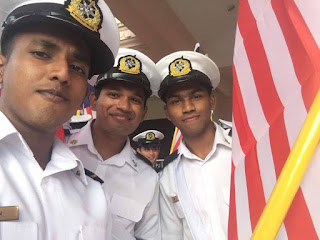A sailor, seaman, mariner, or seafarer is a person who
navigates waterborne vessels or assists as a crew member in their operation and
maintenance. The term bluejacket may be used for British or US Navy enlisted
sailors, the latter especially when deployed ashore as infantry. The
Bluejacket's Manual is the basic handbook for United States Navy personnel.
700,000 of the world's mariners come from the Philippines, being the world's
largest origin of seafarers. Etymologically, the name "sailor" preserves the
memory of the time when ships were commonly powered by sails, but it applies to
the personnel of all vessels, whatever their mode of propulsion, and includes
military (naval) and security (coast guard) maritime personnel and members of
the merchant marine, as well as recreational sailors. The term
"seaman" is frequently used in the particular sense of a sailor who
is not an officer.
Deck Department.
Officer positions in the deck department include but
are not limited to: master and his chief, second and third officers. The
official classifications for unlicensed members of the deck department are able
seaman and ordinary seaman. With some variation, the chief mate is most often
charged with the duties of cargo mate. Second Mates are charged with being the
medical officer in case of medical emergency. All three mates each do four-hour
morning and afternoon shifts on the bridge, when underway at sea.
A common deck crew for a ship includes:
- · Captain / Master
- · Chief Officer / Chief Mate
- · Second Officer / Second Mate
- · Third Officer / Third Mate
- · Boatswain (unlicensed Petty Officer: Qualified member Deck Dept.)
- · Able seamen (unlicensed qualified rating)
- · Ordinary seamen (Entry-level rating)
- Deck Cadet / unlicensed Trainee navigator / Midshipman
Engineering Department.
A ship's engineering department consists of the members of a
ship's crew that operates and maintains the propulsion and other systems on
board the vessel. Marine engineering staff also deals with the
"hotel" facilities on board, notably the sewage, lighting, air
conditioning and water systems. Engineering staff manage bulk fuel transfers,
from a fuel-supply barge in port. When underway at sea, the second and third
engineers will often be occupied with oil transfers from storage tanks, to
active working tanks. Cleaning of oil purifiers is another regular task.
Engineering staff are required to have training in firefighting and first aid.
Additional duties include maintaining the ship's boats and performing other
nautical tasks. Engineers play a key role in cargo loading/discharging gear and
safety systems, though the specific cargo discharge function remains the
responsibility of deck officers and deck workers.
A common engineering crew for a ship includes:
- · Chief Engineer
- · Second Engineer / First Assistant Engineer
- · Third Engineer / Second Assistant Engineer
- · Fourth Engineer / Third Assistant Engineer
- · Motorman (unlicensed Junior Engineer: Qualified member Engine Dept.)
- · Oiler (unlicensed qualified rating)
- · Entry-level rating Wiper
- · Engine Cadet / unlicensed Trainee engineer
We should appreciate the struggle and sacrifices that sailors are making as the nature of their job is the toughest in the world where the are responsible to deliver the goods needed by every country in order to keep us comfortable and live a happy life.
SOURCE: https://en.wikipedia.org/wiki/Sailor




Comments
Post a Comment